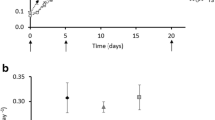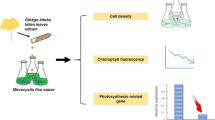Abstract
Toxic Microcystis species are the main bloom-forming cyanobacteria in freshwaters. It is imperative to develop efficient techniques to control these notorious harmful algal blooms (HABs). Here, we present a simple, efficient, and environmentally safe algicidal way to control Microcystis blooms, by using intermediate carboxylic acids from the tricarboxylic acid (TCA) cycle. The citric acid, alpha-ketoglutaric acid, succinic acid, fumaric acid, and malic acid all exhibited strong algicidal effects, and particularly succinic acid could cause the rapid lysis of Microcystis in a few hours. It is revealed that the Microcystis-lysing activity of succinic acid and other carboxylic acids was due to their strong acidic activity. Interestingly, the acid-lysed Microcystis cells released large amounts of phycocyanin, about 27-fold higher than those of the control. On the other hand, the transcription of mcyA and mcyD of the microcystin biosynthesis operon was not upregulated by addition of alpha-ketoglutaric acid and other carboxylic acids. Consider the environmental safety of intermediate carboxylic acids. We propose that administration of TCA cycle organic acids may not only provide an algicidal method with high efficiency and environmental safety but also serve as an applicable way to produce and extract phycocyanin from cyanobacterial biomass.





Similar content being viewed by others
References
Bai SJ, Huang LP, Su JQ, Tian Y, Zheng TL (2011) Algicidal effects of a novel marine actinomycete on the toxic dinoflagellate Alexandrium tamarense. Curr Microbiol 62(6):1774–1781
Bai S, Li J, He Z, Van Nostrand JD, Tian Y, Lin G, Zhou J, Zheng T (2013) GeoChip-based analysis of the functional gene diversity and metabolic potential of soil microbial communities of mangroves. Appl Microbiol Biotechnol 97(15):7035–7048
Boussiba S, Richmond AE (1979) Isolation and characterization of phycocyanins from the blue-green alga Spirulina platensis. Arch Microbiol 12:155–159
Carman KR, Dobbs FC (1997) Epibiotic microorganisms on copepods and other marine crustaceans. Microsc Res Tech 37(2):116–135
Cheng YS, Zheng Y, Labavitch JM, VanderGheynst JS (2013) Virus infection of Chlorella variabilis and enzymatic saccharification of algal biomass for bioethanol production. Bioresour Technol 137:326–331
Cheung MY, Liang S, Lee J (2013) Toxin-producing cyanobacteria in freshwater: a review of the problems, impact on drinking water safety, and efforts for protecting public health. J Microbiol 51(1):1–10
Churro C, Fernandes AS, Alverca E, Sam-Bento F, Paulino S, Figueira VC, Bento SP, Lobo AM, Martins LL, Mourato MP, Pereira P (2010) Effects of tryptamine on growth, ultrastructure, and oxidative stress of cyanobacteria and microalgae cultures. Hydrobiologia 649(1):195–206
Eriksen NT (2008) Production of phycocyanin—a pigment with applications in biology, biotechnology, foods and medicine. Appl Microbiol Biotechnol 80(1):1–14
Ginn HP, Pearson LA, Neilan BA (2010) NtcA from Microcystis aeruginosa PCC 7806 is autoregulatory and binds to the microcystin promoter. Appl Environ Microbiol 76(13):4362–4368
Glibert PM, Anderson DM, Gentien P, Graneli E, Sellner KG (2005) The global, complex phenomena of harmful algal blooms. Oceanography 18(2):136–147
Hilborn ED, Soares RM, Servaites JC, Delgado AG, Magalhães VF, Carmichael WW, Azevedo SM (2013) Sublethal microcystin exposure and biochemical outcomes among hemodialysis patients. PLoS One 8(7):e69518
Jiménez C, Cossío BR, Labella D, Niell FX (2003) The feasibility of industrial production of Spirulina (Arthrospira) in Southern Spain. Aquaculture 217(1):179–190
Kaya K, Liu YD, Shen YW, Xiao BD, Sano T (2005) Selective control of toxic Microcystis water blooms using lysine and malonic acid: an enclosure experiment. Environ Toxicol 20(2):170–178
Kong Y, Xu X, Zhu L, Miao L (2013) Control of the harmful alga Microcystis aeruginosa and absorption of nitrogen and phosphorus by Candida utilis. Appl Biochem Biotechnol 169(1):88–99
Kuniyoshi TM, Gonzalez A, Lopez-Gomollon S, Valladares A, Bes MT, Fillat MF, Peleato ML (2011) 2-Oxoglutarate enhances NtcA binding activity to promoter regions of the microcystin synthesis gene cluster. FEBS Lett 585(24):3921–3926
Li L, Pan G (2013) A universal method for flocculating harmful algal blooms in marine and fresh waters using modified sand. Environ Sci Technol 47(9):4555–4562
O’Neil JM, Davis TW, Burford MA, Gobler CJ (2012) The rise of harmful cyanobacteria blooms: the potential roles of eutrophication and climate change. Harmful Algae 14:313–334
Ogbonda KH, Aminigo RE, Abu GO (2007) Influence of temperature and pH on biomass production and protein biosynthesis in a putative Spirulina sp. Bioresour Technol 98(11):2207–2211
Patel A, Mishra S, Pawar R, Ghosh PK (2005) Purification and characterization of C-phycocyanin from cyanobacterial species of marine and freshwater habitat. Protein Expr Purif 40(2):248–255
Patil G, Raghavarao KSMS (2007) Aqueous two phase extraction for purification of C-phycocyanin. Biochem Eng J 34:156–164
Patil G, Chethana S, Sridevi AS, Raghavarao KS (2006) Method to obtain C-phycocyanin of high purity. J Chromatogr A 1127(1–2):76–81
Qiu D, Wei H, Tu Q, Yang Y, Xie M, Chen J, Pinkerton MH Jr, Liang Y, He Z, Zhou J (2013) Combined genomics and experimental analyses of respiratory characteristics of Shewanella putrefaciens W3-18-1. Appl Environ Microbiol 79(17):5250–5257
Raps S, Kycia JH, Ledbetter MC, Siegelman HW (1985) Light intensity adaptation and phycobilisome composition of Microcystis aeruginosa. Plant Physiol 79(4):983–987
Rodrigues MS, Ferreira LS, Converti A, Sato S, de Carvalho JC (2011) Influence of ammonium sulphate feeding time on fed-batch Arthrospira (Spirulina) platensis cultivation and biomass composition with and without pH control. Bioresour Technol 102(11):6587–6592
Romay CH, González R, Ledón N, Remirez D, Rimbau V (2003) C-phycocyanin: a biliprotein with antioxidant, anti-inflammatory and neuroprotective effects. Curr Protein Pept Sci 4(3):207–216
Schmidt RA, Wiebe MG, Eriksen NT (2005) Heterotrophic high cell density fed-batch cultures of the phycocyanin producing red alga Galdieria sulphuraria. Biotechnol Bioeng 90:77–84
Sekar S, Chandramohan M (2008) Phycobiliproteins as a commodity: trends in applied research, patents and commercialization. J Appl Phycol 20:113–136
Silveira ST, Burkert JF, Costa JA, Burkert CA, Kalil SJ (2007) Optimization of phycocyanin extraction from Spirulina platensis using factorial design. Bioresour Technol 98(8):1629–1634
Singh NK, Parmar A, Madamwar D (2009) Optimization of medium components for increased production of C-phycocyanin from Phormidium ceylanicum and its purification by single step process. Bioresour Technol 100(4):1663–1669
Stanier RY, Kunisawa R, Mandel M, Cohen-Bazire G (1971) Purification and properties of unicellular blue-green algae (order Chroococcales). Bacteriol Rev 35(2):171–205
Thangam R, Suresh V, Asenath Princy W, Rajkumar M, Senthilkumar N, Gunasekaran P, Rengasamy R, Anbazhagan C, Kaveri K, Kannan S (2013) C-Phycocyanin from Oscillatoria tenuis exhibited an antioxidant and in vitro antiproliferative activity through induction of apoptosis and G0/G1 cell cycle arrest. Food Chem 140(1–2):262–272
Vega-Palas MA, Flores E, Herrero A (1992) NtcA, a global nitrogen regulator from the cyanobacterium Synechococcus that belongs to the Crp family of bacterial regulators. Mol Microbiol 6:1853–1859
Wang CY, Wang X, Wang Y, Zhou T, Bai Y, Li YC, Huang B (2012) Photosensitization of phycocyanin extracted from Microcystis in human hepatocellular carcinoma cells: implication of mitochondria-dependent apoptosis. J Photochem Photobiol B 117:70–79
Wei L, Li X, Yi J, Yang Z, Wang Q, Ma W (2013) A simple approach for the efficient production of hydrogen from Taihu Lake Microcystis spp. blooms. Bioresour Technol 139:136–140
Acknowledgments
This work was supported by the Chinese Academy of Science Grant Y15103-1-401 and One-Hundred Scholar Award to D.Q.
Conflict of interest
An application has been submitted for a Chinese patent (application number 201310669686.9) partly based on this work.
Author information
Authors and Affiliations
Corresponding author
Additional information
Responsible editor: Robert Duran
Rights and permissions
About this article
Cite this article
Bai, S., Dai, J., Xia, M. et al. Effects of intermediate metabolite carboxylic acids of TCA cycle on Microcystis with overproduction of phycocyanin. Environ Sci Pollut Res 22, 5531–5537 (2015). https://doi.org/10.1007/s11356-014-3730-x
Received:
Accepted:
Published:
Issue Date:
DOI: https://doi.org/10.1007/s11356-014-3730-x




